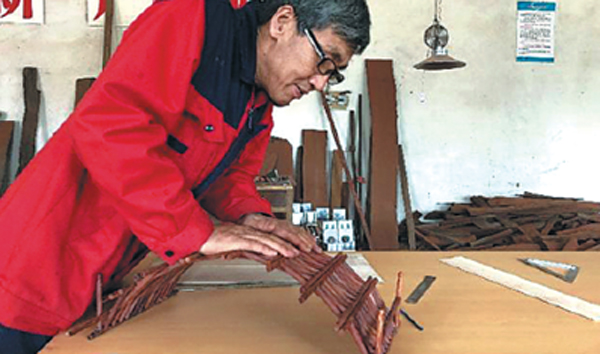Man makes preserving heritage a joint effort
 0 Comment(s)
0 Comment(s) Print
Print E-mail China Daily, July 16, 2018
E-mail China Daily, July 16, 2018
Woodworker Sun Gang has spent most of his life learning and preserving the traditional mortise and tenon technique widely found in ancient Chinese buildings and furniture.

Some old buildings contained no nails, and instead used interlocking joints to connect pieces of wood, with the earliest example of a mortise and tenon structure dating back 7,000 years to the Hemudu culture in what is now Zhejiang province.
"The mortise and tenon structure is our ancestors' great wisdom," said Sun, 52.
Born in a village in Gansu province, Sun dropped out of primary school after just three years.
His father taught him carpentry and he began to do woodwork at 13.
"At that time my family was so poor we could barely afford any furniture or tools," he recalled.
"But my father and I made plows, wooden tables and chairs by ourselves.
"It was hard to find iron nails. Instead, my father taught me how to make simple mortise and tenon joints and use them to assemble little gadgets. It was then that I fell in love with the craft."
Sun has come a long way from being a fan of mortise and tenon structures to preserving an intangible cultural heritage in the city of Dingxi, Gansu.
He left home in 1987 to look for work in neighboring cities as a decorator and furniture maker.
After 10 years of hard work, Sun had saved a large sum of money and honed his carpentry skills. In 1998 he returned home and started his own business - producing large quantities of modular furniture that found a ready market.
However, his mortise and tenon skills were going to waste, with nails and glue used in large-scale industrial production instead.
"Traditional redwood furniture made with mortise and tenon joints is known for its shape, curves and technique," Sun said.
After conducting market research in Shanghai and Guangdong province, Sun found the idea of making furniture the traditional way had huge market potential.
His first sale of a piece of furniture built using the mortise and tenon technique - a wooden roundback chair - made him 6,000 yuan ($900).
In 2014, Sun set up a company to produce and sell tailored cultural and creative products, including furniture and wooden handicrafts featuring mortise and tenon joints.
In his 300-square-meter factory in Dingxi, he displayed just how strong the wooden joints are by putting his entire weight on a handmade wooden arch bridge, which did not even budge.
"Those marvelous mortise and tenon joints enable the wood bridge to carry a weight beyond our imagination," he said.
"Wooden components are perfectly joined together without nails and can stay firm for thousands of years."
Among his woodwork, Sun is very proud of a pair of wooden vases. "The components fit each other perfectly and you cannot see a single tiny crack," he said. "The vases attracted an offer of 400,000 yuan, but I did not sell them."
His company had sales of more than 1 million yuan last year.
Sun said that throughout his career, he has always believed the ancient technique should be passed on to younger generations so more people can know about it.
"Classic, traditional art is permanent and must be better preserved," Sun said.
He was chosen as one of the preservers of the provincial intangible cultural heritage in Gansu last year, and has shared his skills with more than 10 people including his son, Sun Yacheng, who sees his father as a great inventor.
"It is a hard job to make mortise and tenon structures, but my father succeeds because of his intelligence," Sun Yacheng said. "Even several senior engineers cannot do what he does."
His father said: "It is not easy to maintain inner peace and tranquillity in today's busy world, but dealing with the mortise and tenon joint structure can help you. Believe it or not, I can spend hours working on a piece with the traditional joint structure."
To better spread and share the mortise and tenon craft, Sun Yacheng has his own plan.
"I will use mortise holes and tenon tongues to design new interactive toys for children," he said.
"Interactive toys are a good way to develop children's intelligence and help with their dexterity. They can also learn about craftsmanship while playing games."





